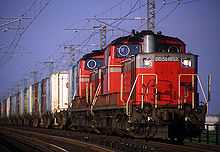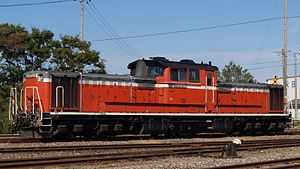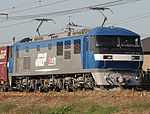JNR Class DD51
| DD51 | |
|---|---|
|
DD51 1027 | |
| Type and origin | |
| Power type | Diesel-hydraulic |
| Builder | Hitachi, Kawasaki, Mitsubishi |
| Build date | 1962 - 1978 |
| Specifications | |
| UIC classification | B-2-B |
| Gauge | 1,067 mm (3 ft 6 in) |
| Wheel diameter | 860 mm |
| Length | 18,000 mm |
| Width | 2,951 mm - 2,971 mm[1] |
| Height | 3,956 mm |
| Locomotive weight | 84 tonnes |
| Transmission | Hydraulic |
| Performance figures | |
| Maximum speed | 95 kilometres per hour (60 mph) |
| Power output | 2,200 hp |
| Career | |
| Operator(s) | JNR, JR Hokkaido, JR East, JR Central, JR West, JR Freight |
| Number in class | 649[1] |
| Disposition | Operational |
The DD51 is a class of Japanese B-2-B wheel arrangement diesel-hydraulic locomotives. 649 locomotives were built between 1962 and 1978 by Kawasaki Sharyō, Hitachi, and Mitsubishi. The class was designed for mainline passenger and freight use with more power than the D51 and a higher maximum speed than the C62 steam locomotive classes. This was achieved by installing two 1,100 hp engines in an 18 metre long centre-cab design, unusual for mainline operation. The V12 DML61 engines were developed from the 6-cylinder inline DMF31 engines used in the DD13 locomotives.[2]
Variations
Locos numbered from DD51 501 to 799 and from 1001 to 1186 were equipped to operate in multiple, and locos numbered DD51 800 to 899 and 1801 to 1805 were built without steam generators for train heating.[2]
Liveries
All locomotives numbered from DD51 2 onwards were finished in the standard diesel livery of orange/red with grey upper surfaces separated by a white stripe. Re-engined locos operated by JR Freight in Hokkaidō sport a livery based on the DF200 colour scheme, with no white stripe. These locomotives are frequently used in pairs double-heading freight trains.
JR Hokkaidō locos are all finished in the "Hokutosei" livery of blue with a gold stripe and shooting star logo. These are used in pairs for hauling sleeper trains (Hokutosei, Cassiopeia, and Twilight Express) between Hakodate and Sapporo.[3]
DD51 592 (now withdrawn), and now DD51 791, was repainted in the "Euroliner" livery of pale blue with dark blue stripes for use with JR Central's "Euroliner" Joyful Train set.
DD51 842 was designated as the Imperial Train locomotive. Whereas regular members of the class have white handrails and edges to the running boards, they are polished stainless steel on this particular locomotive, as are the exhaust shrouds. Based at Takasaki Depot, it is also used for special excursion trains.[3]
-

DD51 842 on an Imperial Train working, October 2001
-
DD51 1095 in JR Hokkaido Hokutosei livery, February 2010
-

JR Central DD51 791 in Euro Liner livery
-

DD51 1166 in JR Freight blue livery initially applied to refurbished locomotives, July 2006
-

DD51 1803 in JR Freight red livery applied to refurbished locomotives, August 2007
Refurbishment

As of April 2003, there were 138 DD51s still in service, with the vast majority operated by JR Freight. Of these, many have recently undergone life extension refurbishment, which includes removal of steam generator equipment where still fitted. These locos are distinguished by a new livery of blue with grey upper surfaces separated by a white stripe, and cream end panels.
DD51 class locomotives also formed the basis for the DD17, DD18, and DD19 self-propelled snow plough units.[3]
Fleet allocation
As of 1 April 2009 the DD51 fleet was as follows.[4]
- JR Hokkaido: 13 (including 1 stored)
- JR East: 4
- JR West: 9
- JR Freight: 68
Preserved examples
The prototype, DD51 1, with its unique, more rounded appearance, was moved to the Usui Pass Railway Heritage Park in April 1998 and repainted in its original livery of brown with white lining. This locomotive was withdrawn March 1986, and was subsequently stored at Takasaki Depot from March 1987.[1]
-

Prototype DD51 1 preserved at the Usui Pass Railway Heritage Park, April 2011
See also
References
- "Tetsudō Zukan" (Railway Picture Book) JR & JNR Edition, Ikaros Publishing 1998
- ↑ 1.0 1.1 1.2 Ishii, Yoshitaka (2004). DD51物語 [The DD51 Story]. Tokyo, Japan: JTB Can Books. ISBN 4-533-05661-X.
- ↑ 2.0 2.1 Inoue, Kōichi (1999). 国鉄機関車辞典 [JNR Locomotive Encyclopedia]. Japan: Sankaido. p. 176-177. ISBN 4-381-10338-6.
- ↑ 3.0 3.1 3.2 JR全車輌ハンドブック2006 [JR Rolling Stock Handbook 2006]. Japan: Neko Publishing. 2006. ISBN 4-7770-0453-8.
- ↑ Japan Railfan Magazine: July 2009 issue
| Wikimedia Commons has media related to JNR DD51. |
| ||||||||||||||||

